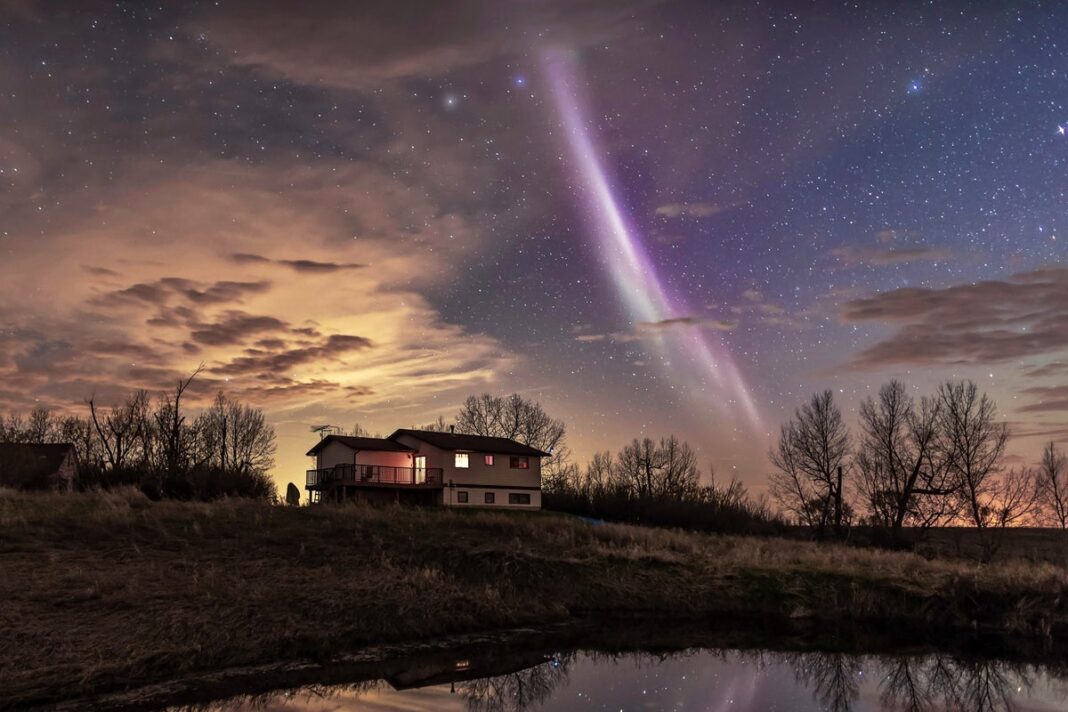Aurora Scientists Enlist Private Astronauts on Unusual Space Mission
The commercial astronauts onboard SpaceX’s Fram2 mission are flying closer to Earth’s poles than anyone has before, offering an intriguing opportunity for auroral science
STEVE (strong thermal emission velocity enhancement) is seen in the night sky over a house in southern Alberta, Canada.
Alan Dyer/Stocktrek Images/Alamy Stock Photo
Four passengers that launched onboard a SpaceX rocket on Monday are bound for a new orbital destination—looping from pole to pole, perpendicular to Earth’s equator—on a mission dubbed Fram2 in a nod to a Norwegian polar ship.
Prior to Fram2, crewed missions only reached orbits of up to 65 degrees inclination to the equator. This means no astronauts have ever flown in space over Antarctic terrain or much north of Iceland. But interesting things happen in the atmosphere at higher latitudes—most famously, auroras. Especially during periods of increased solar activity, these displays are typically visible at northern and southern latitudes of around 68 degrees during the night and 78 degrees during the day, painting a glowing oval around each pole. Other astronauts, particularly those on the International Space Station, have seen auroras from space, but Fram2 crew member Jannicke Mikkelsen is hoping to bring more science to the observations.
While planning Fram2’s activities, Mikkelsen teamed up with Katie Herlingshaw, a space physicist at Norway’s University Center in Svalbard, who works with an aurora-observing, crowdsourced science project to understand brilliant atmospheric phenomena. “People are pretty much everywhere, and they’ve all got phones, so they’re making, really, the densest observation network ever,” Herlingshaw says.
On supporting science journalism
If you’re enjoying this article, consider supporting our award-winning journalism by subscribing. By purchasing a subscription you are helping to ensure the future of impactful stories about the discoveries and ideas shaping our world today.
Herlingshaw built on that community to develop a network of skywatchers to track the Fram2 flight and look for auroras along its path in both the Northern and Southern Hemispheres. She hopes that Mikkelsen will be able to use these observations to capture unique footage of the displays from the spacecraft’s windows. Scientific American spoke with Herlingshaw about the project and its goals.
[An edited transcript of the interview follows.]
How will these observations be different from satellite data? What’s the value of having actual people up there?
The satellite images that we do have are usually focused on photographing the whole auroral oval in one wavelength type, such as ultraviolet. But what we’re really interested in is small features, things that come and go quite quickly. We don’t really have a good way to capture these features from polar-orbiting satellites.
We now have a human up there who can change the camera settings, change the pointing direction and be aware of what’s coming up on her orbit. [Mikkelsen] is taking these very high-resolution videos, and we have full-color images as well. It’s quite a unique setup because these are the first people who have ever been there.
What phenomena are you hoping to see? And how do they relate to auroras?
A lot of people use the term “aurora” for anything that’s caused by charged particles coming in from space along Earth’s magnetic field lines, impacting particles in the atmosphere and causing some kind of light emission. So the idea is that these particles should come from space. But there are some light emissions that are caused locally—inside our own atmosphere—by very fast-moving plasma, for example. It’s a bit of a debate about whether to call those “aurora” or just “auroralike.”
So we’re calling them “weird aurora” as an umbrella term. These are all relatively newly published findings about features that we don’t completely understand.
For example, we’ve noticed these fragmented auroralike emissions—I just call them fragments. They don’t look like the nearby regular aurora, which is kind of lined up vertically in the magnetic field line direction; the fragments, they’re coming off almost perpendicularly. That also points to the fact that these things are not coming in from space—something local is happening.
Sometimes near these fragments, we have something called continuous emission. We’re trial naming this as “ghost aurora” because it’s white. Auroras are usually not white—they can appear that way because your eyes are surprisingly bad at picking up faint colors. So a lot of people see a gray kind of smudge in the sky or something, but if you look at it with scientific instruments that can pick out these colors, usually you’ll see, like, a green or a red or a blue. White is unusual for us because it means all the colors [of visible light] are present and combined together to make the white. That’s weird for the aurora, and it suggests some kind of heating effect going on in the atmosphere that’s managing to excite all of these different colors, but we don’t yet fully understand the mechanism behind it.
Those are at high latitudes. For the people who are a bit farther south, they often see this other type of aurora called STEVE. STEVE also can be whitish in color, and we also sometimes see, nearby, these other things called streaks, which look and behave a lot like fragments. We’re interested in: Why do these things look like this? Why do they act like this? And why do we see similar things at completely different places?
What do you hope that you’ll accomplish during the mission?
We’ll be really happy if we even get just one set of nice observations. All we really need is just one time where [Mikkelsen] sees some of these weird auroras paired with some observations from the ground. Best case, then we’re having more than one, as many as possible. But it’s kind of like trying to thread a needle with these things. You need the spacecraft going over somewhere that is dark, and then we have to check that it’s not cloudy there and that the aurora is active over there and that people are actually awake and photographing it from the ground.
We would like to make some triangulations to pinpoint exactly what altitudes these are happening at. We’re hoping to maybe look at their three-dimensional structure, and that can also perhaps help us figure out the associated mechanisms and light emissions. We’ve also got radars in place to tell us information about how hot it is up there, how fast things are moving, what the density of the particles is. We would like to be able to say what these weird auroras are caused by, but it really depends on what kind of data we get.
What do people need to know if they might want to take part?
People need to have the correct time set on their camera. We can’t use the observation if it’s the wrong time, and clocks recently switched around in some parts of the world. It’s good to have the accuracy down to the second if possible. And then, when you’re out there, also collect a location for your observation. We need those two things.
For real-time notification to the astronaut, we’re asking people to post on various Facebook groups. The project website’s photography instructions include a map of all of the different ones. People should join the nearest group to them or one of the more global groups in each hemisphere.
But we cannot use these social media posts for science because as soon as you upload something to Facebook, the resolution and all of the information about the time and the exposure just disappear. So we also ask people to submit to a platform called Skywarden—and in the observation story, put #SolarMaxMission. Observations that are submitted here can win some prizes that have been to space as well—[Mikkelsen] is flying some Fram2 mission patches to give away.





